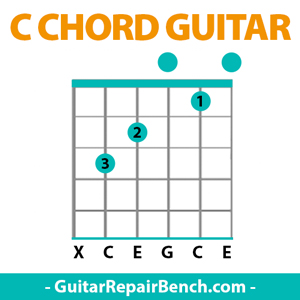 Learning to play a C chord on guitar is one of the most rewarding things for beginner guitarists. With its many finger positions and chord variations, this is an easy first chord to play.
Learning to play a C chord on guitar is one of the most rewarding things for beginner guitarists. With its many finger positions and chord variations, this is an easy first chord to play.
Plus, C is one probably the most popular acoustic guitar chord because it works so well in songs of different keys. That’s another reason why this is a great chord to learn as a beginner. You can do so much with it!
Let’s talk about the music theory of the C chord as well as how to form it in your fingers.
What is a C Major Chord on Guitar?
Contents
What notes are in a C chord?
C major is a triad chord compound by three notes: C, E, and G. The C note is the root note followed by the E note, the major third that two steps from the root , and the G – the perfect fifth that is three and a half steps from the root, C.
When working on C major key, it’s important to keep in mind that this is the only major key that does not use altered notes – this meaning that no sharps nor flats in the key of C. This makes it pretty easy to work with!
C Chord Guitar Finger Positions
You can easily play a C chord on acoustic guitar in several different positions on the guitar neck. Here are the first six chord positions and variations you can play a C-chord on guitar neck.
- Open chord
- 3rd position
- 5th position
- 8th position
- 10th position
- 12th position
How to Play an Open C Chord on Guitar
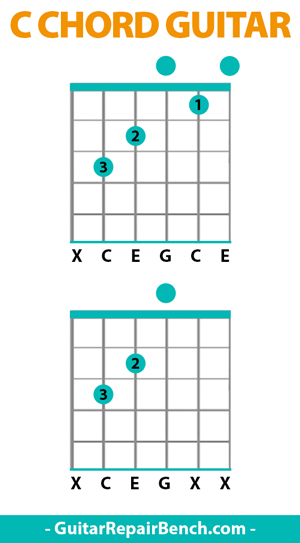 Making the C major open chord fingering can be a bit challenging for a beginner. That’s why I split the open chord into two different C chord variations and fingering positions. Both start on the C note on guitar string number 5. You can work on the easier one and work your way up to the more difficult one.
Making the C major open chord fingering can be a bit challenging for a beginner. That’s why I split the open chord into two different C chord variations and fingering positions. Both start on the C note on guitar string number 5. You can work on the easier one and work your way up to the more difficult one.
Open C Major Finger Position #1
First, you can start by placing your 1st finger on the 1st fret of the B string.
After that, put your 2nd finger on 2nd fret of the D string.
Lastly, set your 3rd finger on the 3rd fret of the A string.
Now strum the first five strings.
Open C Major Finger Position #2
Sometimes using all three of your fingers at once can be a bit challenging, so you can make a shortened version of the open C chord by simply using your 2nd and 3rd fingers like we did in the first chord and only playing the 3-5 strings to make the C major triad.
Short tip for beginners: When learning basic guitar harmony, C major usually appears to be the most troublesome open chord. This is mostly because this particular case demands the guitarist to place fingers 1, 2 and 3 on different frets – in consequence, the left hand (right if you are left handed) needs to develop a considerable elongation capacity in order to open up wide and reach each fret properly.
If you are having a hard time playing the C major open chord, you can try splitting the fingering and practicing it separately – first, working with fingers 1 and 2, then with fingers 2 and 3, and lastly with fingers 1 and 3. Once you feel comfortable doing this exercise, take a shot with the complete chord.
5 Different C Chord Guitar Variations
How to Play a C Chord at the 3rd Fret
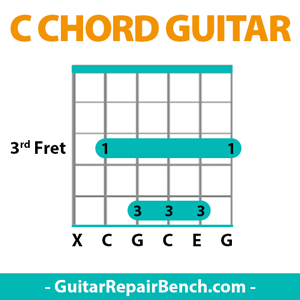 Begin by putting your 2nd finger on the 5th fret of the D string.
Begin by putting your 2nd finger on the 5th fret of the D string.
Next, place your 3rd finger on 5th fret of the G string, and right after that, set your 4th finger on the 5th fret of the B string.
Lastly, make a bar with your 1st finger across the 3rd fret. You don’t have to play the low E string since the right hand won’t be playing it, but you can add it in for a little extra bass note at the bottom of the chord.
C Major Chord Guitar Tip: I like to barre the 2-4 strings with my third finger. I’ve found that it’s easier than trying to get three different fingers lined up and then putting the first finger barre down. Try it both ways and see which way you think is easier.
How to Play a C M Guitar Chord at the 5th Fret
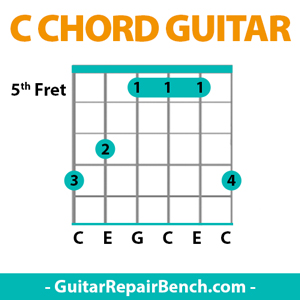 This chord is similar to the open G chord shape. You are just using your first finger to barre the strings at the fifth fret.
This chord is similar to the open G chord shape. You are just using your first finger to barre the strings at the fifth fret.
I like to place my third finger on the 8th fret of the low E string and then put my second finger down on the 7th fret of the A string.
Once those are placed, I can find the 8th fret of the high E string for my 4th finger.
After all those fingers are down, you can use your 1st finger to make a half bar on 5th fret, pressing the first four strings of the fretboard.
Guitar Chord Shape Tip: It’s easiest to start this chord shape like you are making an open G chord. Then just add the first finger barre. There’s nothing to it!
How to Play a C M Chord at the 8th Fret
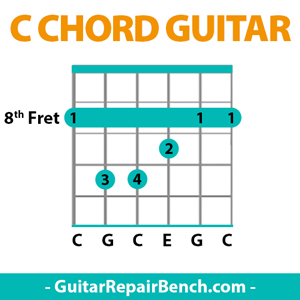
First, use your 1st finger to press on the 8th fret across all the frets on the fretboard.
Then, position your 3rd finger on the 10th fret of the A string and your 4th finger on the 10th fret of the D string.
Lastly, place your 2nd finger on the 9th fret of the G string and strum all the strings like you are a rockstar.
C Guitar Chord Position Tip: I like to make a C power chord with my 1, 3, and 4 fingers to start this chord. Then after I have to position right, I add in the rest of the chord. It’s makes it much easier.
How to Play a C Major Guitar Chord at the 10th Fret
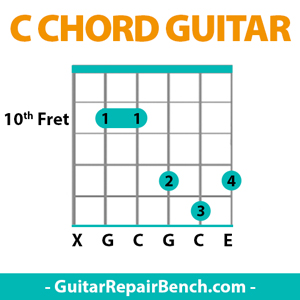 This C chord shape can be a bit tricky. The trick is to get your 2-4 fingers set in place before you try to make the barre.
This C chord shape can be a bit tricky. The trick is to get your 2-4 fingers set in place before you try to make the barre.
First, stick your 2nd finger on the 12th fret of the G string, and your 3rd finger on the same fret, but on the high e string.
Next, rest your 4th finger on the 13th fret of the B string.
Finally, barre your first finger across the 10th frets of the A and D strings.
How to Play a C Major Chord on the 12th Fret
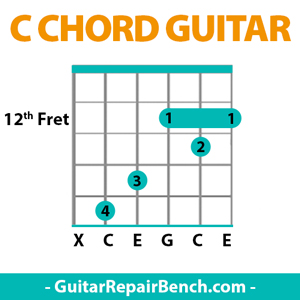 The C chord at the 12th fret on the fretboard is exactly one octave upon the open chord. If you look closely this C M guitar chord shape looks identical to the open shape because it’s the same formation.
The C chord at the 12th fret on the fretboard is exactly one octave upon the open chord. If you look closely this C M guitar chord shape looks identical to the open shape because it’s the same formation.
The only thing different about it is you use your first finger to hold down all of the strings on the 12th fret similar to hold the nut holds down the open strings. Look at the similarities in C guitar chord chart to the right.
I’ve found the easiest way to make this chord is to place all of your fingers on the fretboard and then add in the first finger barre. So first, place your fourth finger on the 15th fret of the A string.
Then place your third finger on the 14th fret of the D string and your second finger on the 13th fret of the B string.
Now place your first finger across all of the strings on the 12th fret and strum the first 5 strings. You just played your first C chords on the second octave of the guitar.
Time to Start Playing!
Now that you learned how to play C on guitar, you can start working on other guitar chords and begin learning songs! C is an awesome chord because it’s so versatile and can fit into so many different musical arrangements.
Learning how to play different C chord variations and finger positions on the fretboard will give you tons of options in your playing and song writing. Each position makes the chords sound slightly different because the notes are higher and in different orders. This makes it really fun to experiment with new combinations.
If you want learn more about guitar chords and how to use them, you should sign up for guitar lessons online. They teach you everything you need to know about music theory, strumming patterns, techniques, solos, and pretty much everything else. It’s improved my playing. Check it out.

